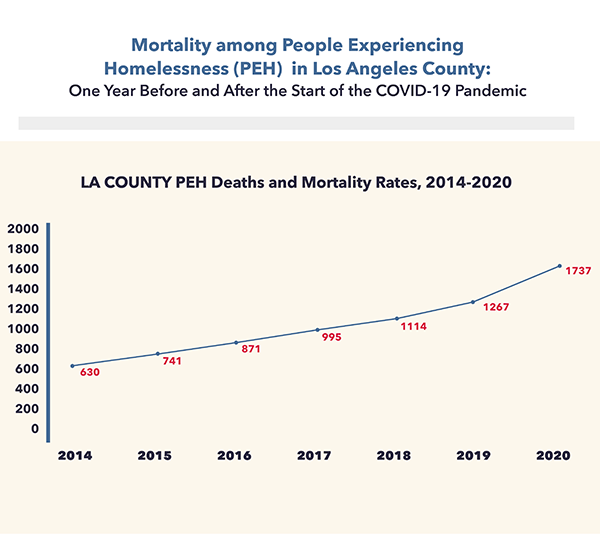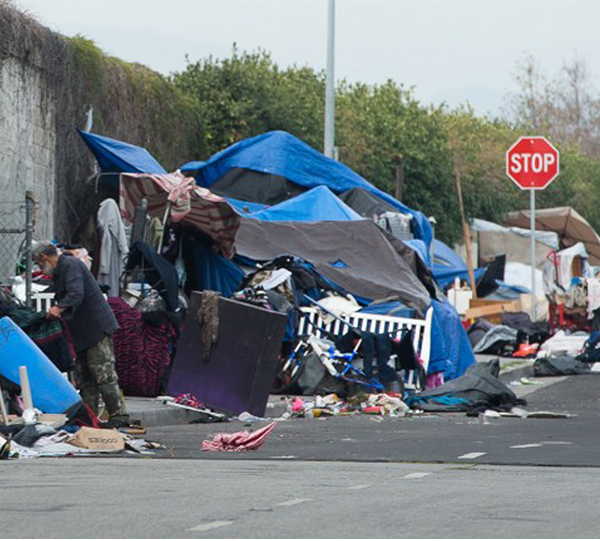The Los Angeles County Department of Public Health (Public Health) released the third annual report on mortality among people experiencing homelessness (PEH) in LA County. This new report compares deaths among PEH during the 12-month period preceding the first reported PEH COVID-19 death in the county (April 1st, 2019-March 31st, 2020) and the 12-month pandemic period that followed (April 1st, 2020-March 31st, 2021).
The overall number of deaths among PEH increasedby 56%, from 1,271 to 1,988 deaths, between the two 12-month periods. During the post-pandemic onset period there were 179 COVID-19 deaths among PEH, accounting for 25% of the observed increase.
Excluding these deaths, the number of deathsamong PEH still increased by 43%.
Drug overdose (OD) remained the leading cause of death among PEH during both years, and OD deaths increased by 78% from the pre- to post-pandemic onset year. Coronary heart disease was the second leading cause of death in both years and increased by 29% between the two years.
COVID-19 was the third leading cause of death among PEH in the post-pandemic onset year and these deaths were much more likely to occur among those under age 65 than deaths for this age group in the general population. Traffic injury and homicide were the fourth and fifth leading causes of death in the post-pandemic onset year; deaths from these causes increased by one-third and one-half, respectively.
Younger PEH experienced particularly large increases in deaths, including a doubling of deaths among those aged 18-29 and a 70% increase among those aged 30-49. Latinx saw the largest absolute increase in deaths, with 334 more deaths in the post-pandemic onset year—a 69% increase.
Deaths among Black PEH increased by 58% and deaths among White PEH increased by 39%. While there were only 18 more deaths among Asian PEH in the post-pandemic onset year, this represented more than twice the number of deaths in this group compared to the pre-pandemic year.
Relative increases in OD deaths followed similar demographic patterns as those for all deaths, with a doubling of OD deaths among PEH under age 50, and a greater increase in OD deaths among Latinx (84%) compared to Blacks (74%) and Whites (67%). Most OD deaths involved multiple drug types.
While methamphetamine was the drug type involved in the largest percentage of OD death in both years (73% and 75%, respectively), fentanyl was the only drug type whose involvement in OD death increased, with 27% involving fentanyl during the pre-pandemic year and 45% involving fentanyl in the post-pandemic onset year.
Note that the annual LA County homeless count provides population denominators for the calculation of PEH mortality rates, but since the 2021 count was cancelled due to the pandemic this new report compares numbers and characteristics of deaths but not death rates.
“The findings in this report reflect a true state of emergency on the streets across our County,” said Supervisor Hilda L. Solis, co-author of the 2019 motion addressing rising homeless mortality. “In a civil society, it is unacceptable for any of us to not be profoundly disturbed by the shocking needs documented in this year’s homeless mortality report. We must redouble our efforts to address this crisis. As part of our response, it is critical that we address the drug epidemic, particularly the rise of fentanyl on our streets. The availability of Narcan coupled with housing and services is fulcrum to our response. Since 2019, the County’s Overdose Education and Naloxone Distribution program has provided overdose prevention education and naloxone to individuals at risk of opioid overdose. As the Supervisor who represents the whole of Skid Row, where tragically many of these mortalities occur, I will be requesting that American Rescue Plan funding be leveraged in addition to other funding to help solve this moral crisis of our lifetime.”
“The COVID-19 pandemic’s impact on people experiencing homelessness has clearly extended beyond the immediate effects of this new and deadly virus. The pandemic has exacerbated stressors already burdening this vulnerable population, contributing to increases in other causes of death even as COVID-19 mitigation efforts were stepped up in shelters and encampments.,” said Barbara Ferrer, PhD, MPH, MEd, Director of Public Health. “While efforts to prevent the spread of COVID-19 remain critically important, we must also implement effective strategies that address the other leading causes of death among this vulnerable population, most importantly the tragic continued rise in drug overdose deaths.”
The County’s plan for preventing future homeless deaths includes:
- Expanding and improving field-based, harm reduction-oriented substance use disorder treatment services, with an explicit focus on reaching Latinx and Black PEH;
- Increasing distribution of naloxone to PEH in street settings and shelter/interim housing settings, and PEH exiting jails and prisons;
- Expanding and enhancing county-contracted Substance Use Disorder provider utilization of the Homeless Management Information System to improve coordination of care and housing-focused case management for PEH with SUDs;
- Increasing investments in Recovery Bridge Housing to ensure PEH, including those exiting jails and prisons, receive outpatient SUD treatment services and permanent housing placements;
- Implementing infectious disease protocols in shelters, encampments, and other congregate settings where PEH live;
- Further investigation of PEH homicide and traffic injury deaths.
To view the full report online, visit: http://publichealth.lacounty.gov/chie.



